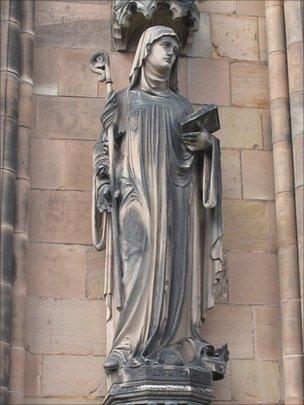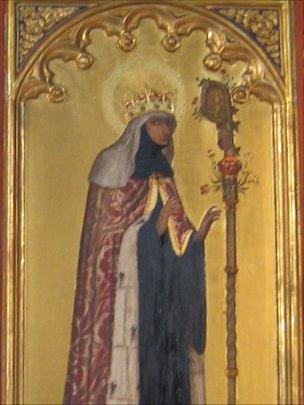On the trail of the Mercian Anglo-Saxon saints
- Published

Saint Werburgh was the daughter of a king of Mercia
In the period when the Staffordshire area was the centre of the mighty kingdom of Mercia, Christianity re-arrived in the English Midlands.
And, with the discovery of crucifixes in the Staffordshire Hoard, there is now new interest in these early Anglo-Saxon Christians.
Over the 400 years of the Mercian period, the faith inspired hermits, missionaries and healers.
It also produced saints who are remembered to this day.
Here we remind you of the lives of the saints Modwena, Werburgh, Chad and more - all of whom lived in or around the period of the Staffordshire Hoard treasure trove, which is believed to have been buried in the ground around 700.
These saints brought Christianity back to England after its first flowering (in Roman times) had been suppressed following the Germanic invasions of the 7th Century.
Not all the stories and legends of these saints are to be believed as fact, but still stand as testament to the way Christianity fed into the times.
See photo-gallery: Looking for evidence of Saxons in Staffordshire
For stories that might just be legends, see Mercia: the facts and the legends.
Modwena
St Modwena (or Modwen) may nowadays be associated with Burton-upon-Trent, but she was actually Irish.
She arrived in what is now Burton in the 7th Century and built a small chapel on Andressey Island (St Andrew's Isle), where she used the local water to heal disease. It is claimed she even cured the prince who was later to become King Alfred the Great.
But her lasting legacy to Burton is its brewing tradition. In 1004, the then Earl of Mercia, Wulfric Spot, built an abbey in the town in tribute to her. The monks also found the local water to be special and started using it to brew beer - and the rest is history.
Memories of her surfaced again when the Staffordshire tycoon Sir Stan Clarke named his development company in her name. And there have been a few local beers named after her.

St Werburgh is also celebrated in this altar screen at Stafford St Chads. It was created by Walter Tapper in 1910.
Werburgh
St Werburgh (or Werburga/ Werburh) was born near Stone early in the 7th Century, the daughter of the first Christian Mercian king, Wulfhere, and his wife Saint Ermenilda.
A devout woman, she opted for a religious life and became prioress of a nunnery at Hanbury (in east Staffordshire) which had been founded by her uncle King Ethelred I. Hanbury, on the River Dove, had a huge strategic importance in this era, and was close to Ethelred's seat at Tutbury
She became a religious reformer, working with her uncle, and reorganising the nunneries across Mercia. She died some miles north of Stone at Trentham Priory (another one founded by King Ethelred) in 699/700.
Many astonishing legends are associated with her; and Hanbury, where she was buried, became a site of pilgrimage.
However, when Danish forces threatened the area two centuries later, her body was moved to Chester where it remains still. She is now the patron saint of Chester.
Nevertheless, the present church at Hanbury is dedicated to her.
St Chad (Ceadda)
Though Chad was not the first bishop of Mercia, he is credited with bringing Christianity to the area, and is celebrated in dozens of churches across the Midlands.
Summoned by King Wulfhere to the area to lead missionary work, he was appointed Bishop of Lichfield. The vast Mercian see stretched over the whole of middle England - from the Humber to the Mersey, from the Severn to the Thames.
Though only in post two-and-a-half years, the historian Bede says it was his work that Christianised Mercia.
He died in 672 in Lichfield, where he was buried, and where the cathedral is dedicated to him. St Chad's Head Chapel in the cathedral was a site of pilgrimage following his death, as it was here that his skull was kept...
However his bones were later taken to St Chad's Cathedral in Birmingham where they remain. The casket containing the relics is removed from the church every March 2 and paraded round the surrounding streets.
St Editha
The present great parish church at Tamworth is named after Editha, a princess of Mercia.
The last of the great Mercian saints, she was the daughter of Athelstan, who, starting as the king of Mercia, went on to unify the whole of Saxon England. In an effort to make peace with the Danish Vikings, who controlled the kingdom of Northumbria, Athelstan put the unwilling Editha forward to be married to the Viking king Sihtric.
Perhaps much to Editha's pleasure, Sihtric abandoned both her and his new Christian beliefs within the year. Editha went on to become abbess at Polesworth, only a few miles from Tamworth.
More saints
During the upsurge of Christianity in the area, there were also many other saints.
St Diuma was the first bishop of Mercia (656-8); and St Guthlac fought in the army of King Ethelred before becoming a monk at another Mercian capital, Repton, in nearby Derbyshire.
Ethelred himself (the uncle of St Werburgh), though a warrior king, abandoned the court to became a monk - and was revered by some as a saint though not canonised.
However, there are also some other famous Staffordshire saints, of whom it is impossible to say if they really existed. St Bertram, St Rufin and St Wulfad fall into this category. See our Facts & Legends page.
- Published7 April 2011
- Published16 April 2011